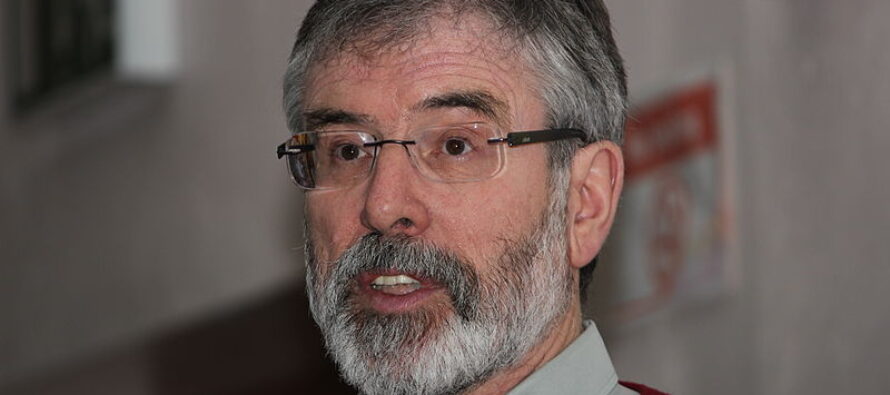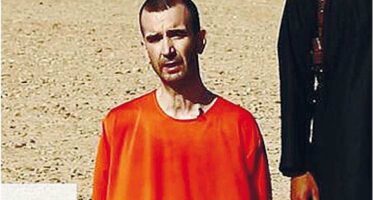Irish America and the Peace Process

![]()
Light was fading over New York when I managed to escape for a brief period to stretch my legs and go for a walk through its streets and avenues. It was a crisp Friday evening and my second in the Big Apple. The previous night we had held our annual Friends of Sinn Féin fund raising dinner. It was a packed event and Seanadóir Rose Conway Walsh, Rita O Hare and I spoke to the 800 guests setting out our concerns around Brexit, the opportunities for progressing our goal of Irish unity, and the crucial role of Irish America in helping to ensure that the new incoming Trump administration adopts the same supportive role toward the Irish peace process that previous democratic and republican administrations have done.
As I walked up 6th Avenue several hundred, mainly young people, jogged passed me. Some were carrying crudely made placards while all were chanting. It took me only a few moments to realise that I was in the middle of a protest against President Trump.
‘Not my President’ some chanted. ‘Sexist, Racist, anti-gay Donald Trump go away’ was another refrain. A snatched glance at several of the placards saw one which read ‘We shall overcomb’, while another read ‘love always wins’ – surrounded by hastily drawn red hearts.
The crowd were quickly gone. They were heading toward Trump Tower which I had passed a short time earlier on 5thAvenue. It’s a big imposing building.
It’s surrounded now by New York City police officers and Secret Service agents. CNN described it as “a fortress ringed by tight security.” Across from the front door is a bank of tv cameras and photographers monitoring every move in and out of the home of the new US President. One innovative journalist or blogger had a piece of wood attached to a strap around his neck – making an improvised desk on which he had his IPad resting – and was busy typing away.
In my three short days in New York I was struck by the sharply divided opinions on the election result from among those I met. Part of Sinn Féin’s success in the USA has been our ability to draw support from both Democrats and Republicans. We have very deliberately stayed out of domestic US politics and elections. Who American citizens vote for is a matter for them. We who have had centuries of foreign interference in our own affairs don’t wish to intrude on the rights of others. That doesn’t mean of course that when appropriate Sinn Féin does not raise issues of concern about US foreign policy with the administration. We do and I have.
Whether it was with President Clinton or Bush or Obama, or with various state department officials, I have voiced Sinn Féin’s opposition about US foreign policy and actions in respect of the Middle East, Israeli aggression against the Palestinian people of the west Bank and the Gaza Strip, in Iraq and Afghanistan and against the people of Cuba.
However, our priority is to defend and advance the Irish peace process; the political and constitutional arrangements that were achieved as a result of the Good Friday and subsequent agreements, and our republican objective of Irish reunification.
So, my appeal to Irish Americans – irrespective of their own political allegiances – was to urge them to stay focussed on and to continue championing the peace process and Irish unity. For over 20 years the Irish America has been the bridge out of Ireland into the political establishment in the USA and the driver for its engagement with the peace process. Irish America has achieved remarkable success.
With Brexit creating greater uncertainty we need Irish America to re-exert its enormous political strength to persuade the new republican administration to continue with US support for peace and progress in Ireland.
This connection between Ireland and Irish America was clearly evident last Saturday morning in New York. Under a beautiful blue sky several hundred grassroots activists came together to celebrate the centenary of the 1916 Rising. Council woman Elizabeth Crawley had proposed that a pedestrian thoroughfare in Maspeth in the Queens Borough be named ‘Easter Rising Way.’
It was a great initiative and New York Council approved it. And as the succession of speakers reminded us Irish America has been an integral part of the Irish story and of the struggle for freedom for hundreds of years.
Maspeth is a strong Irish American community. It is a few hundred yards from Calvary Cemetery where stands the Fenian Monument erected by the Irish Republican Brotherhood in 1907 in remembrance of the Fenians of 1865-67. It is also close to Celtic Park which in the years leading to the 1916 Easter Rising was a major fundraising venue for the IRB and Clan na Gael. In the decade before the Rising at least eight of the 1916 leaders spent some time in that great city, as well as touring across the USA. Both Thomas Clarke and James Connolly had made lives for themselves for a time here and others, including Joseph Plunkett and Roger Casement toured the US seeking support for the struggle.
New York was also the city of the famine Irish who fled to the United States in their hundreds of thousands to escape hunger and persecution under British rule. But before them it was also the home of some of those who fought in the 1798 Rebellion. I remember on one of my first visits to New York being taken by Brian McCabe to St Mark’s-in-the-Bowery Churchyard in the East Village to visit the grave of Thomas Addis Emmet. Thomas Addis was the brother of Robert Emmet and one of the 1798 leaders. After he fled to New York he practised law and for a time was the New York State Attorney General.
Clann na Gael and Fenians like O Donovan Rossa and John Devoy raised money and arms for the cause. Much of it in New York. And when O’Donovan Rossa died it was Tom Clarke who asked that his remains be returned to Dublin where Padraig Pearse’s stirring oration at his graveside in 1915 foreshadowed the 1916 Rising.
The following year when Pearse and others came to write the Proclamation they explicitly praised the role of the Irish in America. The Proclamation states, and I quote, “having patiently perfected her discipline, having resolutely waited for the right moment to reveal itself, she now seizes that moment, and, supported by her exiled children in America and by gallant allies in Europe, but relying in the first on her own strength, she strikes in full confidence of victory.”
Later in the most recent phase of struggle groups like Noraid, Clann na Gael, the Ancient Order of Hibernians, the Irish American Unity Conference and the Brehon Law Society all supported oppressed communities in the north.
But it was with the peace process that Irish America really made an impact on US policy toward Ireland. At a time when the British claimed that the issue of the North was an ‘internal matter’ for them it was Irish America that persuaded US politicians to intervene. Irish America was the driver that put Ireland and the Irish peace process on the agenda of successive US Presidents and kept it there. Irish America persuaded political leaders in the Congress to take risks for peace when it was not popular.
We need Irish America to continue with that work. We especially need it at this critical juncture to engage with their new President and Congress members and Senators, and to persuade them to stay the course with the Irish peace process.
Related Articles
L’Isis e il nuovo orrore: abbiamo ucciso Haines
![]()
Il video sull’esecuzione del cooperante britannico David Haines. Il premier Cameron: pura malvagità
Pakistan, strage nella capitale, 23 morti
![]()
Pakistan. Oltre cento i feriti. Una strage che non ha eguali, nella capitale, dai tempi di quella avvenuta all’Hotel Marriot di Islamabad nel 2008




